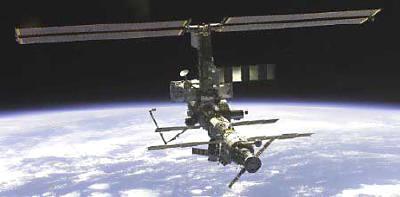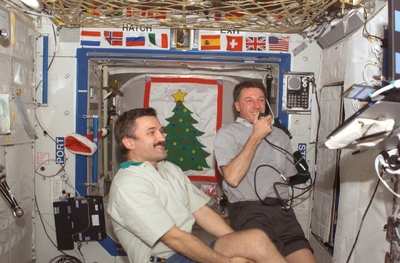Fixing A Leak
Expedition 8 Commander Michael Foale reestablished a vacuum
between the Destiny Laboratory’s science window’s two
panes of optical-quality glass over the weekend. The window work
was associated with continuing repairs following a small pressure
leak detected on the International Space Station in January.

Foale, with help from Flight Engineer Alexander Kaleri,
completed a procedure to remove any condensation that might have
accumulated between the glass panes during removal a damaged flex
hose used to keep the area between the window panes at vacuum. The
final remaining steps in the repairs are construction of a cover to
protect the hose against inadvertent contact and installation of a
new jumper hose that was delivered by the resupply ship Progress
13.

Kaleri continued to troubleshoot intermittent failures of the
Elektron oxygen generation system in the Zvezda service module.
That system, which pulls oxygen from water, is one of several
mechanisms used to provide breathing air. Today, Kaleri and flight
controllers in Moscow restarted the system repeatedly in an effort
to eliminate bubbles in the system. While repairs are ongoing, the
Station’s atmosphere has been repressurized using oxygen from
the Progress spacecraft. Oxygen-generating canisters also are
available, but are not being used at this time.
The first part of the week consisted of time off and light duty
for Foale and Kaleri after last week’s first-ever two-person
spacewalk without a crew member inside the Station. The pair
completed almost three-quarters of the tasks planned before Kaleri
reported that drops of water were beginning to form inside his
helmet visor and that his suit temperature was a little warm. After
cutting short the spacewalk, the pair quickly detected a kink in
one of the tubes in Kaleri's liquid cooling garment. The kink was
straightened out and water began to flow normally.

The crew also worked with several science experiments, notably
the PromISS protein crystal growth experiment. Wednesday, they
stowed the experiment sample in the Aquarius incubator after a
successful 30-day growth cycle.
In Thursday’s regularly scheduled ISS Mission Management
Team meeting, US and Russian managers discussed the status of a
minute pressure decay in the two helium systems that pressurize the
Soyuz 7 vehicle’s propellant tanks and lines. The pressure
decay was first noted on System 2 when the Soyuz arrived at the
Station in October, and was confirmed on System 1 during a thruster
test in preparation for last week’s spacewalk. Russian flight
controllers have concluded that the decay poses no concern. The
decay was extremely small and there are no plans to change normal
entry and landing procedures.
Meanwhile, flight controllers in Houston reported seeing slight
momentary increases in electrical current and vibration readings
from one of the Station's Control Moment Gyroscopes (CMG) earlier
this week. The readings were seen on CMG 3, one of three operating
CMGs on the Station, following normal steps taken as part of a
Station altitude reboost performed Tuesday using thrusters on the
docked Progress cargo craft. All three CMGs continue to function
well now with normal current indications, although flight
controllers continue to evaluate the readings seen in recent CMG
operations. Powered by electricity generated by the Station's solar
arrays, the CMGs provide continuous orientation control of the
Station without using the Station's limited fuel supply.
 ANN's Daily Aero-Linx (04.16.24)
ANN's Daily Aero-Linx (04.16.24) Aero-News: Quote of the Day (04.16.24)
Aero-News: Quote of the Day (04.16.24) Airborne 04.10.24: SnF24!, A50 Heritage Reveal, HeliCycle!, Montaer MC-01
Airborne 04.10.24: SnF24!, A50 Heritage Reveal, HeliCycle!, Montaer MC-01 Airborne 04.12.24: SnF24!, G100UL Is Here, Holy Micro, Plane Tags
Airborne 04.12.24: SnF24!, G100UL Is Here, Holy Micro, Plane Tags Airborne-Flight Training 04.17.24: Feds Need Controllers, Spirit Delay, Redbird
Airborne-Flight Training 04.17.24: Feds Need Controllers, Spirit Delay, Redbird





